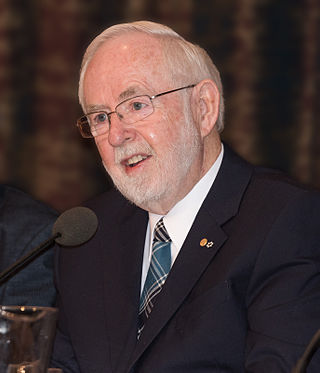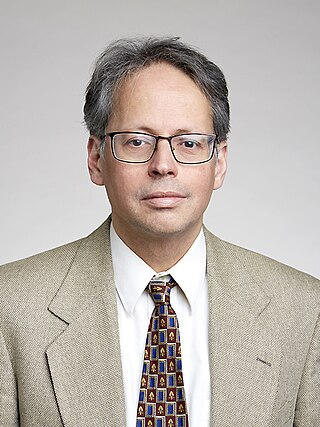
Paul Ching Wu Chu is a Chinese-American physicist specializing in superconductivity, magnetism, and dielectrics. He is a professor of physics and T.L.L. Temple Chair of Science in the Physics Department at the University of Houston College of Natural Sciences and Mathematics. He was the president of the Hong Kong University of Science and Technology from 2001 to 2009. In 1987, he was one of the first scientists to demonstrate high-temperature superconductivity.

Superconductivity is the phenomenon of certain materials exhibiting zero electrical resistance and the expulsion of magnetic fields below a characteristic temperature. The history of superconductivity began with Dutch physicist Heike Kamerlingh Onnes's discovery of superconductivity in mercury in 1911. Since then, many other superconducting materials have been discovered and the theory of superconductivity has been developed. These subjects remain active areas of study in the field of condensed matter physics.
Frank Steglich is a German physicist and the founding director of the Max Planck Institute for Chemical Physics of Solids in Dresden, Germany.
The Mayhew Prize is a prize awarded annually by the Faculty of Mathematics, University of Cambridge to the student showing the greatest distinction in applied mathematics, primarily for courses offered by DAMTP, but also for some courses offered by the Statistical Laboratory, in the MASt examinations, also known as Part III of the Mathematical Tripos. This includes about half of all students taking the Tripos Math exam, since the rest are taking mainly pure mathematics courses. Since 2018 the Faculty have also awarded the Pure Mathematics Prize for pure mathematics, but due to an absence of funds there is no equivalent monetary reward.

Arthur Bruce McDonald, P.Eng is a Canadian astrophysicist. McDonald is the director of the Sudbury Neutrino Observatory Collaboration and held the Gordon and Patricia Gray Chair in Particle Astrophysics at Queen's University in Kingston, Ontario from 2006 to 2013. He was awarded the 2015 Nobel Prize in Physics jointly with Japanese physicist Takaaki Kajita.

The Max-Planck-Institute of Quantum Optics is a part of the Max Planck Society which operates 87 research facilities in Germany.

Matthias Werner Hentze is a German scientist. He is the director of the European Molecular Biology Laboratory (EMBL), co-director of the Molecular Medicine Partnership Unit between EMBL and Heidelberg University, and Professor of Molecular Medicine at Heidelberg University.

Sylvia Serfaty is a French mathematician working in the United States. She won the 2004 EMS Prize for her contributions to the Ginzburg–Landau theory, the Henri Poincaré Prize in 2012, and the Mergier–Bourdeix Prize of the French Academy of Sciences in 2013.

Bernd T. Matthias was a German-born American physicist credited with discoveries of hundreds of elements and alloys with superconducting properties. He was said to have discovered more elements and compounds with superconducting properties than any other scientist.

Maw-Kuen Wu is a Taiwanese physicist specializing in superconductivity, low-temperature physics, and high-pressure physics. He was a professor of physics at University of Alabama in Huntsville, Columbia University, and National Tsing Hua University, the Director of the Institute of Physics at Academia Sinica, the President of National Dong Hwa University, and is currently a distinguished research fellow of the Institute of Physics, Academia Sinica, and international member of National Academy of Sciences.

Robert Joseph Cava is a solid-state chemist at Princeton University where he holds the title Russell Wellman Moore Professor of Chemistry. Previously, Professor Cava worked as a staff scientist at Bell labs from 1979–1996, where earned the title of Distinguished Member of the Technical Staff. As of 2016 his research investigates topological insulators, semimetals, superconductors, frustrated magnets and thermoelectrics.

Hideo Hosono is a Japanese material scientist most known for the discovery of iron-based superconductors.
Merrill Brian Maple is an American physicist. He is a distinguished professor of physics and holds the Bernd T. Matthias Chair in the physics department at the University of California, San Diego, and conducts research at the university's Center for Advanced Nanoscience. He has also served as the director of UCSD's Institute for Pure and Applied Physical Sciences (1995-2009) and its Center for Interface and Materials Science (1990-2010). His primary research interest is condensed matter physics, involving phenomena like magnetism and superconductivity. He has authored or co-authored more than 900 scientific publications and five patents in correlated electron physics, high pressure physics, nano physics, and surface science.
Chen Xianhui is a Chinese physicist. He is a Changjiang professor of physics of the University of Science and Technology of China (USTC). He was elected an academician of the Chinese Academy of Sciences (CAS) in 2015 and is known for his breakthroughs on iron-based superconductors. He won the State Natural Science Award with Zhao Zhongxian and others in 2013 and the Bernd T. Matthias Prize for Superconducting Materials in 2015. His research is mainly on experimental condensed matter physics and materials science.
Venkat Selvamanickam is the M.D Anderson Chair Professor of Mechanical Engineering and a Professor of Physics at the University of Houston. He is also the Director of the Applied Research Hub of the Texas Center for Superconductivity at the University of Houston.

Mark William Gross is an American mathematician, specializing in differential geometry, algebraic geometry, and mirror symmetry.
Arndt Simon is a German inorganic chemist. He was a director at the Max Planck Institute for Solid State Research in Stuttgart.
In physics, the Matthias rules refers to a historical set of empirical guidelines on how to find superconductors. These rules were authored Bernd T. Matthias who discovered hundreds of superconductors using these principles in the 1950s and 1960s. Deviations from these rules have been found since the end of the 1970s with the discovery of unconventional superconductors.










